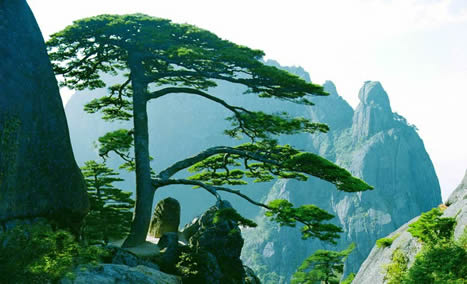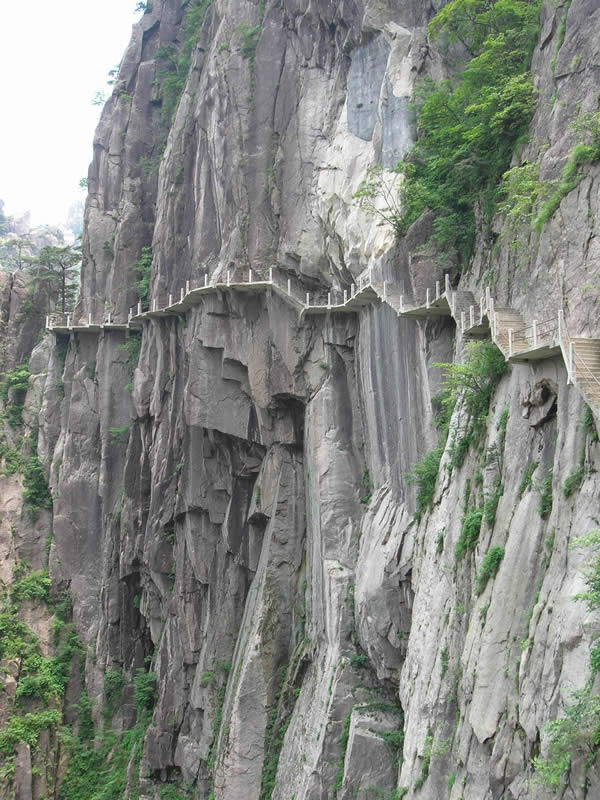 Mt. Huangshan located in the southern part of Anhui Province, the Yellow Mountains (Huangshan in Chinese means yellow mountain) extend across - Shexian, Yixian, Taiping and Xiuning. They rose above the earth surface as a result of movement of the earth's crust over a hundred million years ago. Later they underwent the erosion of Quaternary glaciation and have gradually become what they are today.
Mt. Huangshan located in the southern part of Anhui Province, the Yellow Mountains (Huangshan in Chinese means yellow mountain) extend across - Shexian, Yixian, Taiping and Xiuning. They rose above the earth surface as a result of movement of the earth's crust over a hundred million years ago. Later they underwent the erosion of Quaternary glaciation and have gradually become what they are today. Magnificent and imposing, it is a famous scenic spot full of wonderful sights.The Yellow Mountains known as Yishan in the Qin Dynasty (221 -207 B.C.) got their present name in 747 A.D. (the 6th year of the Tianbao reign of the Tang Dynasty), when Li Bai (701 -762), the great Tang poet, wrote about them in these lines:
Thousands of feet high towers the Yellow Mountains
With its thirty-two magnificent peaks,
Blooming like golden lotus flowers.
Amidst red crags and rock columns.

The Yellow Mountains are a marvel within an area of 154 square kilometres there is a crowd of peaks, 72 of which have names indicating the shapes they resemble. Lotus Brightness Apex and Celestial Capital are the three major ones, all rising above 1,800 metres. The mountains are a body of granite, often with vertical joints. Erosion and fracture contributed to shape the rocks into huge columns giving rise to lofty peaks and deep ravines. When it is cloudy the pinnacles loom in mists as if they were visionary, while in sunshine they unfold in all their majesty and splendour.
The Yellow Mountains change their colour and appearance with the alternation of seasons. In spring blooming flowers decorate the slopes in a riot of colour and fill the valleys with fragrance, in summer you see verdured peaks rising one upon another and near springs gurgling merrily. Autumn dresses the mountains in red and purple, as maples are all blazing - red; winter turns them into a world of frost and ice with silver boughs and rocks everywhere. So from ancient times it has been frequented by tourists seeking their mystery and admiring their scenery.
They come to the conclusion that the fantastic pines, the grotesque rocks, the sea of clouds and the hot springs are the four major attractions of the Yellow Mountains. As a matter of fact there are marvels almost everywhere especially in the following scenic areas: Wenguan (Hot Spring), Yupinglou (Jade Screen Tower), Xihai (West Sea), Beihai (North Sea), Yungusi (Cloud Valley Temple) and Songguan (Pine Valley Nunnery).
Owing to the peculiar terrain, the Yellow Mountains' climate is marked by a vertical change, and the vertical distribution of vegetation is also distinctive: plants on the summit, on the middle levels and at the foot belong to the frigid, temperate and subtropical zones respectively. There are more than 1500 species of plants, of which trees comprise one third. So the Yellow Mountains occupy an important place in China's botanical research. Here you will find century-old pines, firs ginkgoes, Chinese torreyas, Chinese sweet gums, nanmus, camphorwoods and the precious Magua trees, remnants of the glacial era. The Yellow Mountains abound in flowering plants; many of them are rare ones, such as Goddess Flower, the Yellow Mountains Azalea as well as camellia, plum, lily crape myrtle, orchid, Spring Herald Ina Flower and so on. It has a rich store of medicinal herbs; more than 300 kinds are found here, the notable ones being glossy ganoderma, ginseng, Chinese goldthread rhizome and Chinese cinnamon. Maofeng tea of the Yellow Mountains is well known at home and abroad.








No comments:
Post a Comment